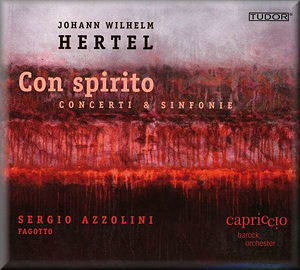 |
 |
|


alternatively
CD:
MDT
AmazonUK
AmazonUS
Sound Samples & Downloads
|
Johann Wilhelm HERTEL (1727 - 1789)
Con spirito
Concerto for bassoon, strings and bc in a minor [17:58]
Sinfonia in D [7:06]
Concerto for bassoon, strings and bc in B flat [14:57]
Sinfonia in G [7:28]
Concerto for bassoon and orchestra in E flat [22:41]
Sinfonia a 6 for two bassoons, strings and bc in B flat* [10:45]
 Sergio Azzolini, Miho Fukui (*), bassoon
Sergio Azzolini, Miho Fukui (*), bassoon
Capriccio Barockorchester/Dominik Kiefer
rec. 17-20 February 2010, Evangelisch-Reformierte Kirche, Arlesheim, Switzerland. DDD
 TUDOR 7182 [82:11]
TUDOR 7182 [82:11] 
|
|
|
Some composers are pretty much known for just one piece. In
the case of Johann Wilhelm Hertel it is his trumpet concerto
in E flat which is in fact a double concerto for trumpet and
oboe. His oeuvre is considerable, though, and includes vocal
music - mostly sacred - and instrumental works. He composed
almost fifty concertos for one or more solo instruments. Three
bassoon concertos are the thread of this Tudor programme by
the Swiss ensemble Capriccio and the Italian bassoonist Sergio
Azzolini.
Hertel was born in Eisenach as the son of Johann Christian,
a violinist and composer who from 1733 was the Konzertmeister
of the court orchestra. It is likely that Johann Wilhelm was
taught the violin by his father. He also received keyboard lessons
from a pupil of Johann Sebastian Bach. In 1742 Johann Christian
was appointed as Konzertmeister of the court orchestra
in Neustrelitz, and his son entered the orchestra as violinist
and harpsichordist. He had close contact with musicians working
at Frederick the Great's court in Berlin, and took violin lessons
from Franz Benda. It brought him also into contact with poets
who were representatives of the Enlightenment, like Lessing
and Ramler. Hertel became an exponent of the Enlightenment as
well. He started to write for a magazine in Hamburg and was
very interested in educating people in musical matters. In the
1760s he moved to the court of Mecklenburg-Schwerin, becoming
the secretary of Princess Ulrike Sophie. In the next years he
composed intermezzi for two plays by Gotthold Ephraim Lessing
for the first German national theatre in Hamburg which were
received well. He also composed oratorios for Ludwigslust, which
since 1767 had been the new residence of the duke of Mecklenburg-Schwerin.
Considering that the number of bassoon concertos - apart from
those by Vivaldi - is not that large Hertel did modern bassoonists
a great favour by composing at least three. And these are no
trifles, but quite substantial works. The first piece on the
programme, the Concerto in a minor, is quite explosive:
one could think that it was written by Carl Philipp Emanuel
Bach. It is an exponent of the Sturm und Drang, with
sudden dynamic outbursts and many twists and turns in the orchestra
and in the solo part. The Concerto in B flat is closer
to the Empfindsamkeit, with many Seufzer and a
highly expressive adagio. In the closing Allegro ma non presto
the bassoonist gets the opportunity to show his skills once
again. As Hertel's concertos were not printed and he himself
didn't date them it is impossible to tell when they were written.
The Concerto in E flat gives the impression of being
a rather late work as it is a fully classical solo concerto.
The orchestra, consisting of strings and pairs of oboes and
horns, is an equal partner of the solo instrument.
The three Sinfonias are also notable for their scoring. The
Sinfonia in G is for strings with two horns in the first
and last movements. The orchestra in the Sinfonia in D reflects
the scoring of the classical orchestra: the strings are joined
by pairs of flutes, oboes and horns. The disc ends with a return
to the baroque era with the Sinfonia a 6 in B flat. It
is for two bassoons, strings and bc, but here the bassoons have
a solo role to play. The piece is in four movements: sinfonia,
Plaisanterie, air largo and a menuet with trio. This structure
and the idiom are reminiscent of the baroque orchestral suite
as they were written by, for instance, Telemann and Fasch.
Hertel is a typical example of a composer whose oeuvre shows
the development from the baroque to the classical style. And
he is certainly no minor master. Capriccio and Sergio Azzolini
have put together an arresting programme. The bassoon concertos
are even quite exciting, also thanks to the performance. Azzolini
is one of the world's leading players of the baroque bassoon,
and he displays the instrument's array of capabilities. There
is some great athleticism in his performances, but also deep-felt
emotion. The orchestra plays with aplomb and the cooperation
between soloist and orchestra is impeccable.
If there is any way to demonstrate that a little-known composer
deserves more attention, this is the way to do it. The character
of the music and the outstanding performances are ample justification
to label this disc 'recording of the month'. Let's hope your
CD player can handle a disc which lasts more than 82 minutes.
Johan van Veen
http://www.musica-dei-donum.org
https://twitter.com/johanvanveen
|
|

